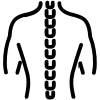Wondering how much time you’ll need off of work to recover from your back condition? Though sick days can vary based on your employer, in the United States, the Family and Medical Leave Act (FMLA) ensures that covered, eligible employees can receive up to 12 weeks of sick leave per 12 months for certain medical conditions. Depending on the situation, back conditions can fall under this category. Below, we’ve gathered everything you need to know about what matters when it comes to sick leave, what doctors recommend, and the potential consequences of longer leaves.
How Long Will You Need to Take Off for Different Types of Back Pain?
There’s no “average” amount of time for sick leave for back conditions, since it depends on the doctor’s recommendations for your specific situation, the kind of work that you do, and what your employer will approve. Generally, though, some conditions take longer to heal from than others. For example, a herniated disk will often require a longer leave—potentially several weeks—than sciatica. However, keep in mind that time off will vary on a case-by-case basis.
What Factors Could Influence the Length of Your Sick Leave?

Several factors, like the condition you have and the severity of your pain, can affect the length of your sick leave. More severe cases often require much more time to rest and recover.
The nature of your job also plays a role. Jobs that are more physically demanding, like those that require you to lift heavy objects, perform repetitive motions, or stand for long hours, will typically require longer sick leave before you’re ready to return to them.
The type of treatment that you receive for your back problem and the recovery time associated with it will also impact the duration of your sick leave. Treatments like surgery or physical therapy take much longer to recover from.
Medical Recommendations for Sick Leave
If you’re experiencing back pain, the first step is to consult a doctor. They’ll thoroughly evaluate your condition and determine the best treatment for your situation. Taking into account the severity of your pain, your medical condition, the demands of your job, the treatment they prescribe, and any necessary recovery time, your doctor might recommend that you take sick leave.
It’s also crucial to monitor your progress through regular medical check-ups—that way, you can make sure that you’re recovering well and can ask to adjust your sick leave if necessary.
Consequences of Longer Sick Leaves
Prolonged sick leave can affect your financial condition, your professional opportunities, and your mental health.
- Financially: Taking an extended leave can often result in a significant loss of income. FMLA, for example, does not require employers to pay their employees while they are on sick leave.
- Professionally: A long absence from work can affect your career progression and professional opportunities.
- Mentally: The isolation and loss of routine that come with longer sick leaves cause stress, anxiety, and even depression in some individuals.
To make your return to work as smooth as possible, communicate openly with your employer and with your healthcare providers. Together, they should help decide on and implement any necessary accommodations you’ll need to make your work environment safe and productive when you get back.
FAQ: What to Know About Taking Sick Leave for Back Pain
How can I go on sick leave for my back condition?
First, schedule an evaluation with a specialist or consult your primary care physician or occupational health doctor to get a clearer idea of what your specific situation requires. Notify your employer about your intention to take sick leave and wait for them to inform you of whether or not you’re eligible under FMLA. Provide them with whatever medical certification may be necessary.
Can I work with lower back pain?
Whether or not you can work with lower back pain depends on the nature of your job and the severity of your condition. It’s important, too, to take precautions to avoid worsening your condition. Taking regular breaks to stay active and making your workplace more ergonomic with tools like a ball chair, a standing desk, or a wrist rest can all be beneficial.
Is back pain considered a disability?
Back pain can be considered a disability under the Americans with Disabilities Act (ADA) if it is severe enough and if it significantly impacts your work and personal life. In such cases, adjustments to your living and working environments may be necessary.
What type of jobs are best for someone with back problems?
If you have back problems, it’s better to have a job that doesn’t strain your back and to work in an ergonomic environment. Roles that allow you to change position as you need and workplaces with ergonomic tools that support proper posture are both practical solutions.











